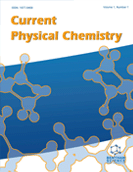Abstract
Background: Anticancer activity of 9-anilinoacridine derivatives has been well reported. Although, the DNA-drug sequence-specific binding of these compounds may be affected by the substituent(s) on the aniline ring, it is still unclear which substituent (NH2 or CH2–OH) on the anilino ring of the compound is the critical element. A good understanding of chemical properties such as steric, lipophilic and electronic properties at the molecular level may provide important background for mutagenic and carcinogenic properties.
Objectives: The present study is an attempt to understand the reactive nature of some selected 9-anilinoacridine derivatives in both gas and solvent phases and to predict their anticancer activity by QSAR analysis.
Methods: Full geometry optimizations of all derivatives were carried out at gradient corrected DFT using DMol3 program. We used DNP basis set in combination with BLYP to study all the derivatives. The molecular mechanics parameters used for QSAR analysis were calculated using Hyperchem software.
Results: We found Compound (31) (R=COOC6H5) as the most stable compound and compound (6) (R1= NO2) as the most reactive one in both gas and solvent phases. Fukui function (f+) values of all the atoms showed that N10 is the most reactive atom in each of the molecule which indicates that N10 is the preferred site for nucleophilic attack. The final QSAR model with four parameters (electrophilicity, hardness, surface area, and molar refractivity) is capable of predicting anticancer activity of the compounds against leukemic HL-60 cell lines with r2 = 0.91 and 0.88 in both gas and solvent phases, respectively.
Conclusion: The global and local reactivity descriptors, such as hardness, chemical potential, electrophilicity index, Fukui function, and local philicity were calculated to understand the reactive nature and reactive sites of the compounds. The comparative QSAR study with the help of DFT and MM + techniques provides the importance of the selected descriptors in predicting the activity of the selected derivatives.
Keywords: Density Functional Theory, Reactivity descriptors, QSAR, Anticancer Activity, Solvent effect
Graphical Abstract
[PMID: 279397]
[PMID: 6357436]
[PMID: 6546898]
[PMID: 6124380]
[http://dx.doi.org/10.1021/jm00017a006] [PMID: 7650675]
[http://dx.doi.org/10.1006/bioo.1996.0021]
[http://dx.doi.org/10.1073/pnas.81.5.1361] [PMID: 6324188]
[PMID: 2988762]
[http://dx.doi.org/10.1021/jm9901226] [PMID: 10579838]
[http://dx.doi.org/10.1021/cr950202r] [PMID: 11848779]
[http://dx.doi.org/10.1002/qua.21285]
[http://dx.doi.org/10.1016/j.jtusci.2015.04.007]
[http://dx.doi.org/10.4018/IJCCE.20190701.oa1]
[http://dx.doi.org/10.1002/qua.21635]
[http://dx.doi.org/10.1007/s10822-009-9265-4] [PMID: 19308327]
[http://dx.doi.org/10.1016/j.jmgm.2020.107682] [PMID: 32739639]
[http://dx.doi.org/10.1007/s00894-009-0551-9] [PMID: 19626352]
[http://dx.doi.org/10.1111/j.1747-0285.2011.01289.x] [PMID: 22151277]
[http://dx.doi.org/10.2174/1386207311316080002] [PMID: 23597248]
[http://dx.doi.org/10.1021/ja01478a001]
[http://dx.doi.org/10.1016/S0031-8914(34)90011-2]
[http://dx.doi.org/10.1021/ja983494x]
[http://dx.doi.org/10.1016/j.jmgm.2005.12.009] [PMID: 16427343]
[http://dx.doi.org/10.1021/ja00326a036]
[http://dx.doi.org/10.1021/ja00099a055]
[http://dx.doi.org/10.1021/ja00279a008] [PMID: 22175316]
[http://dx.doi.org/10.1021/jp973450v]
[http://dx.doi.org/10.1063/1.458452]
[http://dx.doi.org/10.1103/PhysRevA.38.3098] [PMID: 9900728]
[http://dx.doi.org/10.1103/PhysRevB.37.785] [PMID: 9944570]
[http://dx.doi.org/10.1063/1.1677527]
[http://dx.doi.org/10.1063/1.469990]
[http://dx.doi.org/10.1021/ed064p561]
[http://dx.doi.org/10.1021/ja00005a072]
[http://dx.doi.org/10.1021/jm00185a010] [PMID: 7452669]
[http://dx.doi.org/10.1042/bj1750969] [PMID: 743242]
















